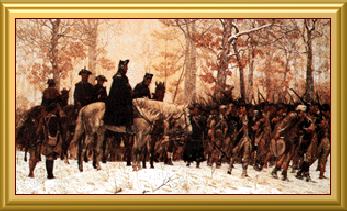

The soldiers represented every state in the new union. Some were still boys -- as young as 12 -- others in their 50s and 60s. They were described as fair, pale, freckled, brown, swarthy and black. While the majority were white, the army included both Negroes and American Indians. Each man had few possessions and these he carried with him. His musket -- by far the most popular weapon -- a cartouche or cartridge box. If he had neither, the infantryman carried a powder horn, hunting bag and bullet pouch. His knapsack or haversack held his extra clothing (if he was fortunate enough to have any), a blanket, a plate and spoon, perhaps a knife, fork and tumbler. Canteens were often shared with others and six to eight men shared cooking utensils.
The first order of business was shelter. An active field officer was appointed for each brigade to superintend the business of hutting. Twelve men were to occupy each hut. The officers' hut, located to the rear, would house fewer men. Each brigade would also build a hospital, 15x25 feet. Many of the Brigadier Generals used local farmhouses as their quarters. Some, including Henry Knox, later moved into huts to be closer to their men. The huts provided greater comfort than the tents used by the men when on campaign. But after months of housing unwashed men and food waste, these cramped quarters fostered discomfort and disease. Albigence Waldo complained, "my Skin & eyes are almost spoil'd with continual smoke." Putrid fever, the itch, diarrhea, dysentery and rheumatism were some of the other afflictions suffered by the Continental troops.
Little is known about the women but there were women at Valley Forge. Junior officers' wives probably remained in the homes of their husbands and socialized among themselves. The enlisted men's wives lived and labored among the troops, some working as housekeepers for the officers; others as cooks. The most common positions were nurse and laundress. A washerwoman might work for wages or charge by the piece.
The army was continually plagued with shortages of food, clothing and equipment. Soldiers relied both on their home states and on the Continental Congress for these necessities. Poor organization, a shortage of wagoners, lack of forage for the horses, the devaluation of the Continental currency spoilage, and capture by the British all contributed to prevent these critical supplies from arriving at camp. An estimated 34,577 pounds of meat and 168 barrels of flour per day were needed to feed the army. Shortages were particularly acute in December and February. Foraging expeditions were sent into the surrounding countryside to round up cattle and other supplies. In February three public markets opened. Farmers were encouraged to sell their produce. Fresh Pork, Fat Turkey, Goose, Rough skinned Potatoes, Turnips, Indian Meal, Sour-Crout, Leaf Tobacco, New Milk, Cyder, and Small Beer were included in the list of articles published in the Pennsylvania Packet and circulated in hand bills.
Entertainment at Valley Forge took many forms. The officers liked to play cricket (known also as wicket) and on at least one occasion were joined by His Excellency, the Commander-in-Chief. Several plays were staged including Joseph Addison's "Cato" which played to a packed audience. A common recreation was drinking, when spirits were available. And the soldiers liked to sing.
Throughout the winter and early spring, men were frequently "on command," leaving camp on a variety of assignments. Units were formed to forage for food, some were granted furloughs, and individuals regularly returned to their home states to recruit new troops. In January Jeremiah Greenman reported, "all ye spayr officers sent home to recrute a nother regiment & sum on furlow."
On February 23, Friedrich Wilhelm Ludolf Gerhard Augustin, Baron von Steuben, arrived at Valley Forge to offer his military skills to the patriot cause. Washington assigned him the duties of Acting Inspector General and gave him the task of developing and carrying out a practical training program. Despite adverse circumstances, Baron Friedrich von Steuben drilled the soldiers regularly and improved their discipline.
Foreign officers were an essential part of the Continental Army. They provided military skills which the Americans lacked. Some, including Steuben, the Marquis de Lafayette and the Baron de Kalb came as volunteers. Kalb quickly proved himself to Washington and Congress commissioned him a major general. Lafayette was given the command of a division of Virginia light troops in December 1777 and later took command of additional troops. Others, such as Engineer Louis Lebèque de Presle Duportail were "covert" aid given leave from the French Army to provide assistance to the Americans. It was Duportail who designed the Valley Forge Encampment.
With spring the balance shifted. New recruits arrived daily. Reluctantly, Nathanael Greene accepted the appointment as Quarter Master General and began to correct the problems with supplies. Under Steuben's direction the Continentals had become professionals, if not career soldiers. Morale improved as confidence grew.
General Orders, Tuesday. May 5, 1778 announced the alliance with France and plans "to set apart a day for gratefully acknowledging the divine Goodness."
On June 19, 1778, six months to the day following their arrival, the Commander-in-Chief General George Washington and the Continental Army departed Valley Forge and marched to Monmouth, New Jersey to engage the British in battle just nine days later.
This was the army that would continue to victory at Yorktown.